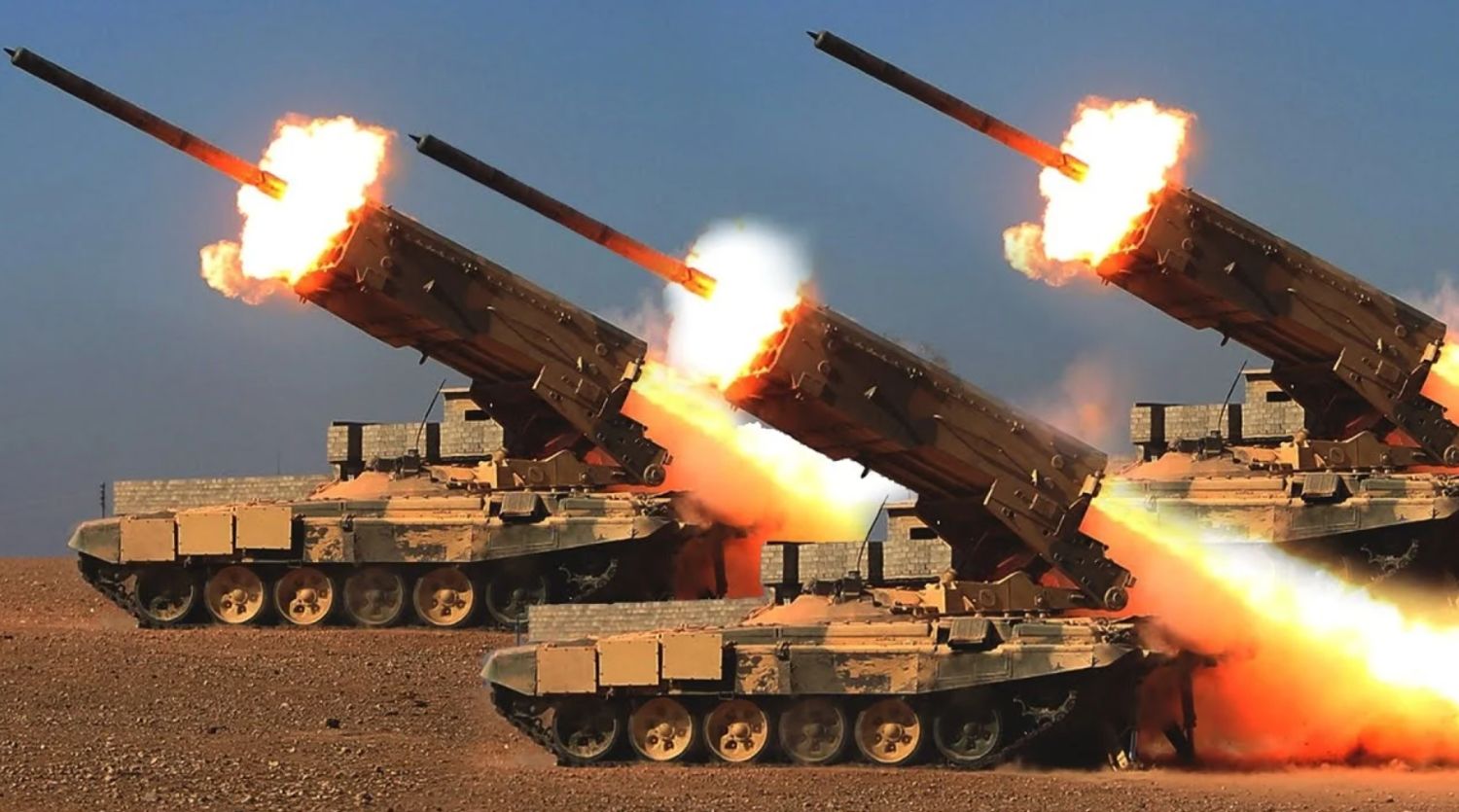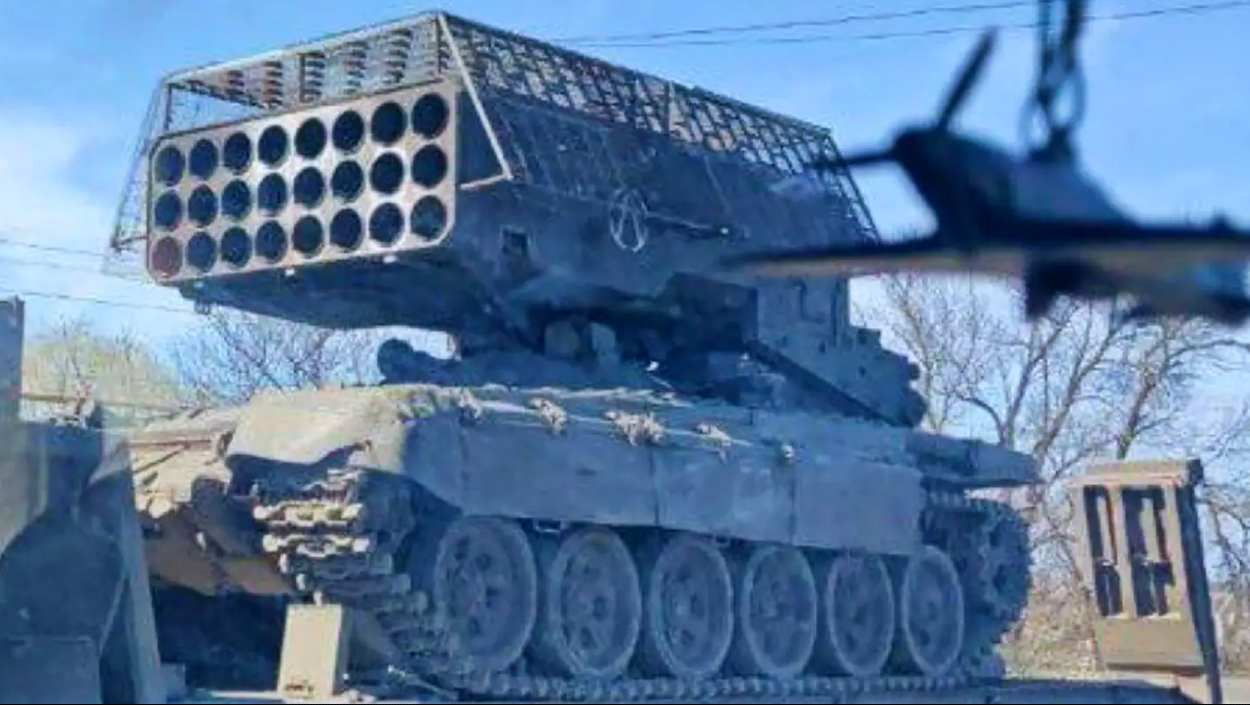The Russian military has hit the Ukrainian army’s strongholds in the Krasny Liman area with ‘super lethal’ TOS-1 Solntsepyok flamethrowers, the group’s spokesman Alexander Savchuk has said.
“In the Krasny Liman area, crews of the heavy flamethrower systems TOS-1A Solntsepyok hit the Ukrainian nationalists’ strongholds,” he said. “Air defense systems have detected and destroyed Ukraine’s unmanned aerial vehicles of the Leleka-100 type,” Savchuk added.
Meanwhile, as Eurasian Times reported, Russia has installed “cope cages” atop its TOS-1 Solntsepyok flamethrowers to minimize the impact of counterattacks.
Cope cages, also called slat armor, bar armor, cage armor, and stand-off armor, are a unique defense employed in heavy military vehicles to lessen the damage brought on by high-explosive anti-tank (HEAT) weaponry.
The first cope cages were spotted on Russian T-80 tanks marching into Crimea in November 2021. At the time, a viral TikTok video showed a Soviet-era T-80 tank trudging through the mud with its turret covered with what looked like a peculiar metal slat roof.
However, soon after, the Ukrainian forces started testing Javelins on static targets that were also caged in response. The outcomes did not bode well for the Russian forces in the following months, which saw Ukrainian ATGMs obliterating several Russian tanks, despite the cages installed on them.
Maj. Gen. Patrick Donahoe (retired), the former head of the Army’s Maneuver Center of Excellence at Fort Benning, Georgia, told EurAsian Times, “The use of slat armor or stand-off armor- has been around since at least World War 2. It has proven effective against High Explosive Anti-Tank (HEAT) warheads by either tearing the warhead apart or forcing early detonation and early forming of the molten jet that is used to penetrate the armored vehicle.

These warheads are known as “shaped charges.” We’ve seen recent employment of these slat armor systems with the RPG Cages that were emplaced on Strykers in Iraq and Afghanistan. The use of dual tandem warheads in modern anti-tank missiles is a way to penetrate these stand-off armor systems and even “reactive” armor that explodes on contact to dissipate the molten jet. The Javelin is such a system.”
After the war started, the Russians also equipped its archaic and frail T-62 tanks with what was then known as “cope cages” before they sent them into battle.
However, the utility of these cope cages have also been questioned by Russia’s troops and military experts who contend that it has caused more harm than good for the tank crews.
Earlier, Russian tank captain Aleksei Ukhachev told the Moskovsky Komsomolets magazine, “We welded grates on top of our tanks, but we wound up removing them. In the first place, the grates cause problems: the machine gun won’t rotate, antennae get caught up in the grate, the radio burns out, and you have no communications.”
The grates, which the tankers called “BBQ grills,” failed to deflect the missiles on the battlefield. Ukhachev continued, saying it was even worse if a crew had to escape a tank with a coping cage on the roof since the metal grate would confine them within the turret.

EurAsian Times reached out to military experts, who came to a similar conclusion about the structure’s efficacy.
Military expert Lt Col J.S. Sodhi (retd) explained, “Cope Cages are welded grates on the top of the tanks to thwart the attack of drones and other missiles. They are bulky and wrap the tank’s turret like a cage. The turret is the most critical part of the tank as it has very thin armor and houses the tank crew, the secondary armament, and radio communication systems.”
He continued, “Experiencing heavy losses of its Armored Fighting Vehicles (AFV) in the prolonged Russia-Ukraine War, Russia has started using “improvised slat armor” also called “cope cages” on its tanks to minimize its losses. Cope cages haven’t been proved effective either in this war or the Armenia-Azerbaijan War of 2020, from where the Russians copied this idea.”
Even though these cope cages are worthless against big air-dropped weapons and anti-tank guided missiles, they might provide some defense against small explosives dropped by commercial drones. No protection is offered by the cages from side attacks from other weapons.
However, if Ukraine decides to ram these systems with heavy drones or rockets, experts believe there are very few chances it will survive.
Mail us at: etdesk (at) eurasiantimes.com




